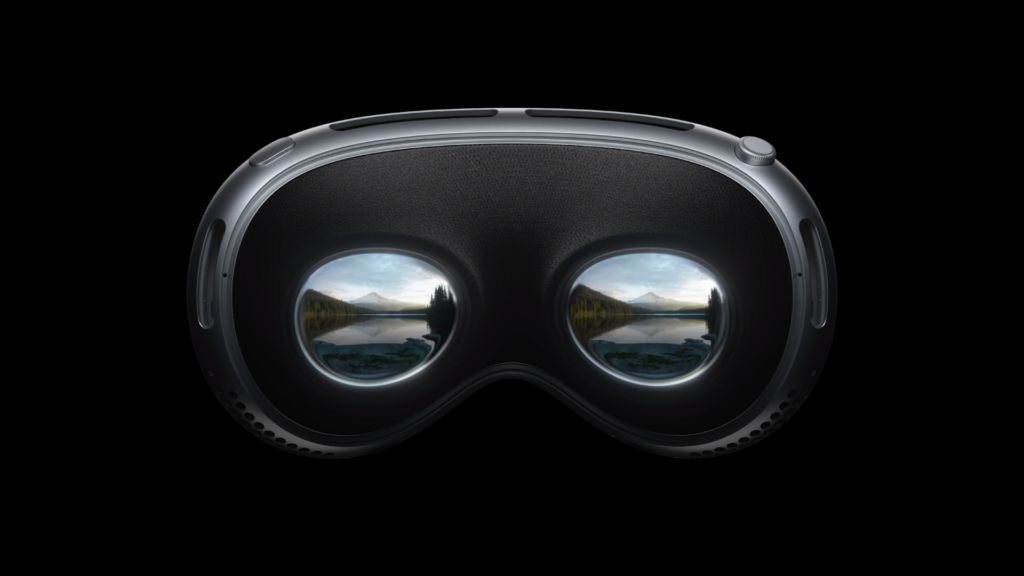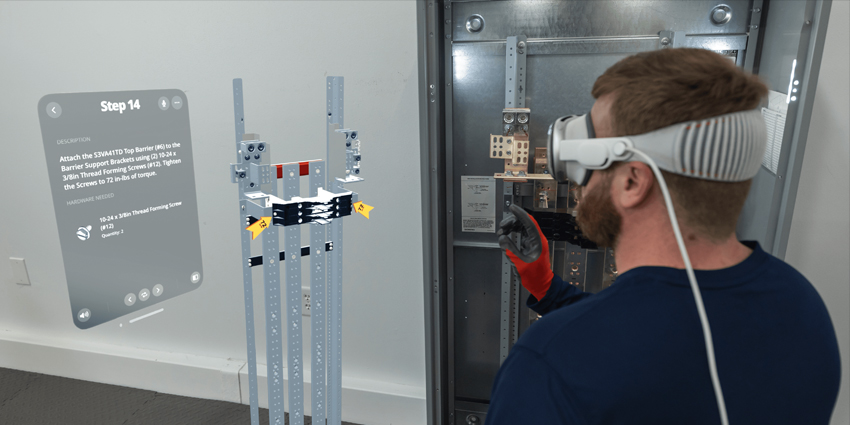Apple has launched its long-awaited mixed reality headset, the Vision Pro, at WWDC.
The controller-free headset will launch at the start of next year, costing $3499 in the US.
The tech giant’s first-ever venture into immersive technologies comes after a two-year snowball of delays and setbacks while developing the device. It is also the first device on offer since the launch of its Apple Watch in 2015.
Introducing the Vision Pro
Opening the big reveal in a keynote speech, Tim Cook, Apple’s Chief Executive, explained that augmented reality was a “profound technology, blending digital content with the real world and unlike experiences like nothing we’ve ever seen.”
The Vision Pro, a new computing device, allows users to interact with digital content using “natural and intuitive tools”. Cook told audiences that headset wearers no longer control the device primarily with handset devices but with their eye gaze, voice, and hand gestures.
He added that users could place their apps in their surroundings, becoming an “infinite canvas” for the wearer. This allows people to capture 3D videos and photos, and watch their favourite programmes and movies.
Tapping the device’s spatial audio, people could seamlessly blend the virtual and physical world, he explained.
Cook continued:
“So in the same way that Mac introduced us to personal computing, and iPhone introduced us to mobile computing, Apple vision Pro will introduce us to spatial computing. This marks the beginning of a journey that will bring a new dimension to powerful personal technology”
Vision Pro Specifications
According to Apple, the new device would carry a trove of high-end specifications such as its visionOS operating system. The world-first spatial OS would allow natural interactions with digital content, complete with a massive 23 million pixel resolution across two huge micro-OLED displays.
Also, the device leverages cutting-edge, catadioptric lenses and ZEISS optical inserts for unrivalled fidelity. The features also enhance eye-tracking capabilities for full interactivity with the headset.

Designed with experiential data from Apple’s macOS, iOS, and iPadOS, the new operating system aims to boost performance and reduce latency for spatial experiences.
It interacts seamlessly with the physical world to overlay content, brighten and dim surroundings, and process human-computer interfacing (HCI) biometrics such as hand, voice, and eye-gaze inputs.
The headset’s EyeSight platform also allows users to interact with others in their physical environments. Those approaching users with the device can see the latter’s eyes as the screen becomes transparent, allowing people to see where the user is focused.

Furthermore, the device integrates the full Apple ecosystem across the headset. This allows seamless usage of iPhones, MacBooks, Watches, and other wearables while using the headset.
The lightweight, compact form factor features 3D milled laminated glass and a bespoke aluminium allow frame for maximum functionality.
Additionally, the headset’s light seal is crafted from textile rather than foam or rubber, while its headband offers a 3D knitted component in multiple sizes.
Visionary Computing Power
Inside the headset, the device comes with a bespoke, dual-chip processor. The Vision Pro would feature an M2 Silicon chip and an R1 graphics processor to deliver cutting-edge, low-latency computing power.
In addition to the massive processing upgrade, the device boasts an array of twelve eye-tracking cameras, five sensors, six microphones, and LEDs to process HCI interactions intuitively. Leveraging the new R1 chip, the headset can stream images in 12 milliseconds for impressive visualisation capabilities.
Additional Features
Productivity: visionOS will also allow displays to appear simultaneously at scale to access apps and multitask between programmes on the headset. It will also allow pairing with Apple’s Magic Keyboard and Magic Trackpad for immersive, remote working experiences in 4K.
Entertainment: The top-spec headset can also immerse users in a virtual theatre setting, no matter their surroundings. With a display replicating a 100-foot-wide theatre screen and 180-degree spatial audio, users can transport to the movies wherever they go. Headset wearers can also access Apple’s growing number of Apple Arcade games while linking the device to select controllers.

Spatial FaceTime: FaceTime users can also leverage the device for speaking directly to other users via a volumetrically-captured ‘Persona.’
Environments: The Vision Pro’s Environments feature will allow users to transform their physical rooms into massive, 360-degree landscapes for full immersion. Using the device’s Digital Crown, people can select and control the level of immersion while using the headset.
3D Filmmaking: Apple’s 3D camera will also allow the Vision Pro to take immersive pictures and video, complete with spatial audio. They can also access their full libraries across iCloud, with panoramic views wrapping around the user.
App Store: According to Apple, its App Store will receive significant updates, where users can access developer apps and content. It has also boosted interoperability with numerous popular apps ported right for the Vision Pro.
Apple Pre-Game Sends Stocks Soaring
Ahead of the event, reports show that the WWDC announcement has sent Apple shares to historic highs, surpassing records of $182.94 from January last year.
On Monday, shares topped $184.73, with a stock increase of 1.80 percent at $184.13 in morning trading hours.
Speaking to Apple Insider, investors told the publication that in the long-term, the XR market would beat scepticism with “technological improvements, new use cases, and lower price points.”
The AR/VR headset market could top $100 billion by 2030 and surpass $500 billion by 2037. This would imply that “AR/VR could become the next major ($20B+) standalone compute platform for Apple,” the analysts added.
Genies Comments on Apple Headset
In a statement seen by XR today, Akash Nigam, CEO, Genies commented on Apple’s Vision Pro headset, adding people should expect “wide skepticism.”
Genies is an XR company specialising in creative content and digital assets linked to retail, gaming, shopping, and other digital assets.
Historical Designing Feats
Commenting on Apple’s history of designing hardware, the executive said,
“Whenever Apple introduces something new, it is met with some type of backlash from both the markets and consumers. But as time has shown, Apple has successfully predicted the behavior of what people will want, not what they want right now, which has led to mass adoption across multiple devices, making them the trendsetters of the hardware industry.”
The Apple Vision Pro also showed the XR industry was “heading into a new form of engagement and communication,” he said.

According to Nigam, the company had “intentionally never been the first to launch computing devices.” However, Apple pioneered its trendsetting technology to drive consumer adoption, he added.
“They’re patient, thoughtful, and prioritize the most important foundational elements,” he added.
Opening the Venture Capital Floodgates
Speaking further on venture capital linked to augmented reality investments, Nigam told XR Today to “expect a significant surge” in investments. He added the market should expect VC firms to ramp up investments in artificial intelligence (AI) mixed with AR.
Doing so will “create a fantasy layer of experiences on top of the real world.” With the latest AI assistant integrations, developers could also “create mini apps in AR” assisted with AI.
He continued: “This will allow people to express themselves at the speed of thought. The spaces that will most likely be impacted from AR integration immediately are shopping, entertainment, and location based experiences.”
Putting the ‘Human’ in Human-Controller Interface
Apple’s latest hardware offering would “allow humans to engage more,” he said. Nigam explained further the need for new human-computer interfacing (HCI) forms.
He added,
“With all the talk of AI replacing humans and human interaction, Apple’s new hardware will cut down on screen time and allow people to further engage in interpersonal activities, which better mimic their normal human activities. As crazy as it may seem, I believe AR hardware will be better for mental health than mobile phones. There needs to be more interaction around experiences instead of mindlessly consuming experiences. Hardware should better mimic human activities and allow people to participate and stay present, versus sit idly and scroll.”
Finally, he stated that current computing devices offered “a new breed of developers, and the barrier to entry typically decreases by a fold of years.”
He concluded: “Expect young gamers and storytellers to become the next generation of builders for experiences and worlds in AR.”







